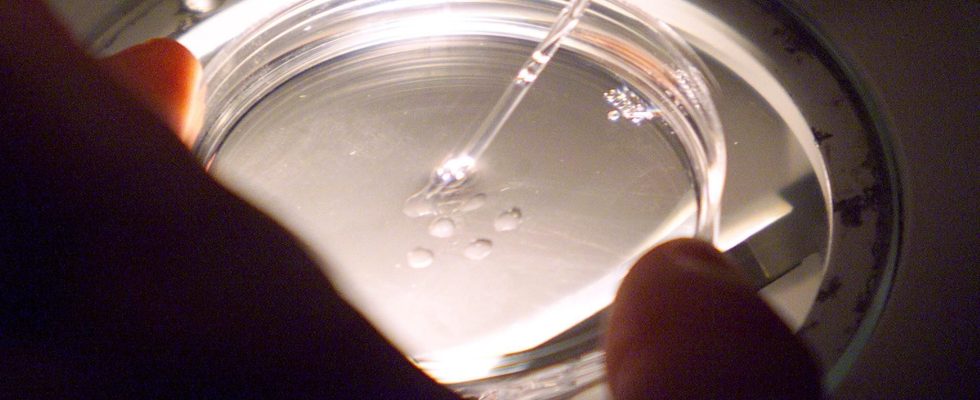Despite a slight delay in ignition and a later publication than its competitors, Jacob Hanna’s team is preparing to become the pioneer of human “embryoids” – more commonly called “synthetic embryos”. On Wednesday September 6, he indeed added a new piece to this monstrously complex puzzle. In a publication in the journal Nature, scientists at the Weizmann Institute of Science in Israel relate how they managed to develop structures similar to a human embryo, without sperm, egg or uterus, from embryonic stem cells. This advance marks a scientific first of rare magnitude, which is part of a series of recent advances. In the spring, several teams – from the universities of Yale in the United States and Cambridge in the United Kingdom – had already published spectacular – and highly publicized – results on the development of human embryoids. This research aims to reproduce the functioning and development of an embryo, but without the need for fertilization.
In the competitive world of research, Jacob Hanna’s team takes first place in the race, with an embryonic model much closer to reality than that of its competitors. Quickly, scientists hailed this work as an “impressive” advance that could unlock the secrets of the first days of pregnancy, this crucial moment when failures are most frequent.
But how is this revolutionary? To keep it simple – as much as possible – the group of researchers used so-called “naive” stem cells. These then have no predefined function, which allows them to be programmed as desired. They have been chemically modified to transform them into four distinct types, necessary for the constitution of an embryo. This is the first breakthrough because, in the majority of other experiments, the cells were modified genetically and not chemically. They gradually became epiblast cells, namely the embryo itself; trophoblast cells, i.e. the placenta; hypoblast cells that form the gestational sac; and extra-embryonic cells of the mesoderm. Aggregated together in a three-dimensional structure, these cells (2,500 in total at the end of the experiment) grew for eight days and began to communicate and assemble spontaneously. In the end, they reproduced all the embryonic structures present in a human embryo on the 14th day of its development. According to the Israeli team, these models, with yolk sac and amniotic cavity, look more like human embryos than anything that had been published so far.
A necessary ethical reflection
Similarities may make these models more effective for research into miscarriages, genital malformations and infertility, said one of the specialists in the field, James Briscoe of the Francis Crick Institute in London. The structure created “appears to produce the different cell types that form tissue at this early stage of development,” he said. This study “is a step toward understanding a period of human development that leads to the failure of many pregnancies, and which has always been very difficult to study until now.” This stage of day 14 is also symbolic, because it is the legal limit for the cultivation of human embryos in the laboratory. A limit which does not apply (at least for the moment) to synthetic embryos, which will therefore be able to go beyond this stage and allow their development to be explored beyond these first two weeks.
However, the researchers behind the study and other scientists insisted that the structures created should not be considered real human embryos. They “strongly resemble them, but are not identical,” the study said. Being devoid of the tissues that allow attachment to the uterus, these structures could not become viable fetuses. Several groups had already published complete animal and human models, called blastoids. As for some partial mouse models, they have progressed to the beginning of heart and brain formation, however still imperfect and inefficient.
Faced with a rare media frenzy for fundamental research, some observers fear the effects of the announcement likely to obscure an ethical reflection that promises to be complex. However, this work is of considerable interest for better understanding the first days of an embryo, a period whose mechanisms remain very mysterious. “We are currently trying to send people to Mars but, strangely enough, we do not know how human life forms. With this research, we have an incredible opportunity to discover where we come from,” says the Frenchman Nicolas Rivron, who himself developed, at the Vienna Academy of Sciences, mouse blastoids in 2018 and human blastoids in 2021, reproducing the blastocyst stage, just before implantation in the maternal uterus.
This recent work shows that “human embryo models are becoming more sophisticated and closer to what can happen during normal development,” said Darius Widera, an expert in cell biology at England’s University of Reading. Will we go as far as creating humanoids in the laboratory? To date, no team has ever succeeded in developing a blastoid reintroduced into a mouse or monkey. The beginning of pregnancy certainly takes place, but it stops less than a week after implantation. “Scientifically we are still very far from it, tempers Nicolas Rivron. And even so, I don’t believe in it. The only legal mode of reproduction is by the fusion of an oocyte and a sperm, and that will not change not”. “We do not want to create life in this way but simply observe it in its beginnings,” confirms Magdalena Zernicka-Goetz. Science fiction, for now, but it’s never too early to think about such probabilities, no matter how small they may be. “This is a golden age to answer many fundamental and medical questions. Let’s not miss the opportunity,” warns Nicolas Rivron. “We must conduct this research, but always in an ethical manner.”
